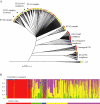Dynamics of Campylobacter colonization of a natural host, Sturnus vulgaris (European starling)
- PMID: 18826435
- PMCID: PMC2702492
- DOI: 10.1111/j.1462-2920.2008.01773.x
Dynamics of Campylobacter colonization of a natural host, Sturnus vulgaris (European starling)
Abstract
Wild European Starlings (Sturnus vulgaris) shed Campylobacter at high rates, suggesting that they may be a source of human and farm animal infection. A survey of Campylobacter shedding of 957 wild starlings was undertaken by culture of faecal specimens and genetic analysis of the campylobacters isolated: shedding rates were 30.6% for Campylobacter jejuni, 0.6% for C. coli and 6.3% for C. lari. Genotyping by multilocus sequence typing (MLST) and antigen sequence typing established that these bacteria were distinct from poultry or human disease isolates with the ST-177 and ST-682 clonal complexes possibly representing starling-adapted genotypes. There was seasonal variation in both shedding rate and genotypic diversity, both exhibiting a maximum during the late spring/early summer. Host age also affected Campylobacter shedding, which was higher in younger birds, and turnover was rapid with no evidence of cross-immunity among Campylobacter species or genotypes. In nestlings, C. jejuni shedding was evident from 9 days of age but siblings were not readily co-infected. The dynamics of Campylobacter infection of starlings differed from that observed in commercial poultry and consequently there was no evidence that wild starlings represent a major source of Campylobacter infections of food animals or humans.
Figures



References
-
- Allos B. Campylobacter jejuni infections: update on emerging issues and trends. Clin Infect Dis. 2001;32:1201–1206. - PubMed
-
- Altman D. Practical Statistics for Medical Research. London, UK: Chapman & Hall/CRC; 1991.
-
- Baker M, Wilson N, Ikram R, Chambers S, Shoemack P, Cook G. Regulation of chicken contamination is urgently needed to control New Zealand's serious campylobacteriosis epidemic. N Z Med J. 2006;119:U2264. - PubMed
Publication types
MeSH terms
Substances
Grants and funding
LinkOut - more resources
Full Text Sources
Other Literature Sources

